Railroad adventure IV: Beijing Xi - Datong
Datong is an old city in Shanxi province with a lot of remnants from what in the West would be the Middle Ages, including a preserved city wall, Buddhist monasteries, the oldest remaining dragon wall in china, and more. So I got a train from Beijing Xi (West) train station to Datong. The trip took a little more than six hours, and there was some amazing scenery outside the windows, including views of the Great Wall.
I started out from Beijing Xi. The always wonderful Ningping accompanied me there in a taxi and guided me so that I would get to the right place.

I thought the station in Basel was big and crowded. This one was enormous in comparison. I took the photo at a moment when it was not so crowded.

The picture above is from the main concourse. On the sides of it were (12, I think) different waiting rooms. A big sign directed travellers to a specific waiting room depending on which train one wanted. Then there was a special waiting room for "mothers with children" (!) and disabled people. Since I am greatly disabled in my knowledge of Chinese, I was allowed to wait there (people in that room get to board the train first).
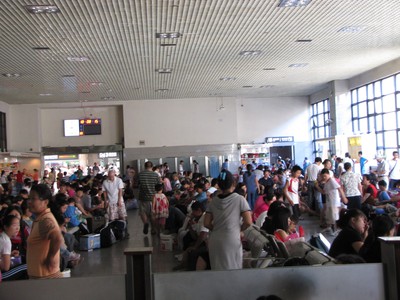
When we first arrived, my train's number was displayed in red, which means that it was delayed. It did not say for how long, and a special sign said (in Chinese; Ningping interpreted) that they were trying to find out how late is was going to be. When I realized that the train had started out from Nancheng in Southern China at 11 a.m. the day before (and was supposed to leave from Beijing at 9.36, I despaired and expected it to be many hours late. Just as I was considering whether I would be able to change my ticket for a later train that might leave earlier did a time pop up for my train.
As you all can see, the sign tells us that the 1483 to Baotou (which is in Inner Mongolia) would leave at 10.12.

The train arrived, and I got onboard to the space that was mine, with kind help from the railway personell. The train (no. 1482/1483) runs Nanchang-Baotou, which is a distance of 2398 kilometers, and which according to the time table takes 35 hours and 4 minutes. I was only on it for a little more than 6 hours.


The train was enormous and absolutely packed. I never saw the end of it. I was in car 12, I walked to car 15-16 before turning around, not even then being sure where the end was. It must have had more than twenty cars. It started and ran very smoothely (Chinese railroads maintains their tracks, even out in the boondogs, considerably better than do American railway companies). Only when the train broke was there ever a jilt. I guess the train does not have the most modern braking pads. The fact that the train number does not have letter in front of it, means that it is an old, "traditional" train that stops often.

Most of the train are cars with couchettes (Sw. "liggvagn"), and I had one of those. The berths were comfortable, and - miraculously - not shorten than I. I even took a nap. But most of the time, I was at the window taking in the view and snapping photos.
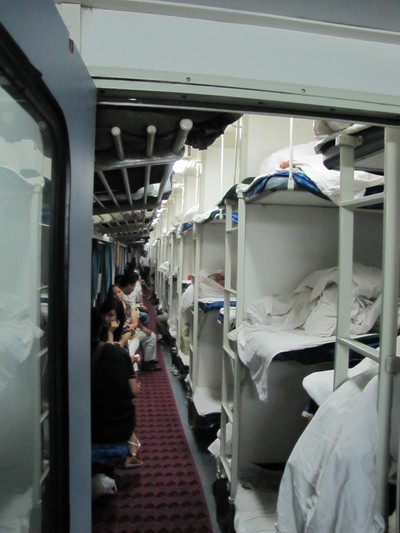
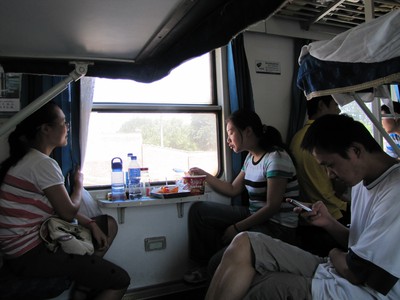
So some view from the windows, dirtier than the Swiss windows, but I have a better camera now, so the pictures came through. Soon after leaving Beijing Xi did we meet a freight train, which was turning off to another route. It was very long, probably some 40 cars, and I think it was headed by two engines (much like the trains of iron ore from Blötberget to Domnarvet in my childhood, for which we often waited forever at the crossing on the way from Ludvika to our home outside town). China transports very much of its internal freight by train. A very good idea.

A clear sign of industrializing China: high-voltage tranfer lines, heavy work in a dry riverbed, and a provisional (?) bridge over it.

Our track was joined by a track coming from the side on a slender bridge. A single track only, but I guess that they are building a second bridgs on those pillars in the foreground.

We approached the mountain range that I think is called the Western Hills. Soon we were going up the mountains, which produced many astonishing sights. Some of the best were visible so briefly that I had no chance of photographing them. There were very many tunnels (can I guess 30-40), some of them very long, several kilometers.
The route we took is a short cut built, I think, in the 1950s to supplement the original route which I believe I shall take back to Beijing.
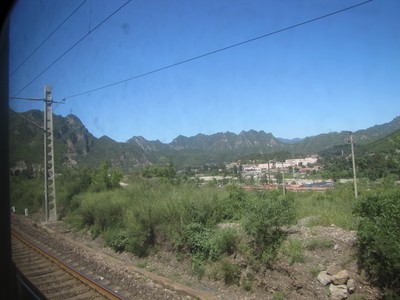
The train windows now produced wonder upon wonder.
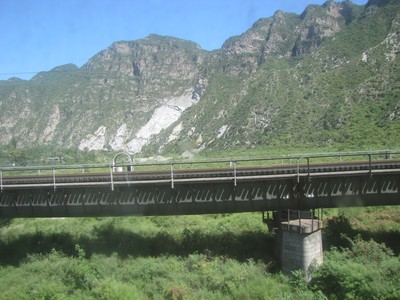

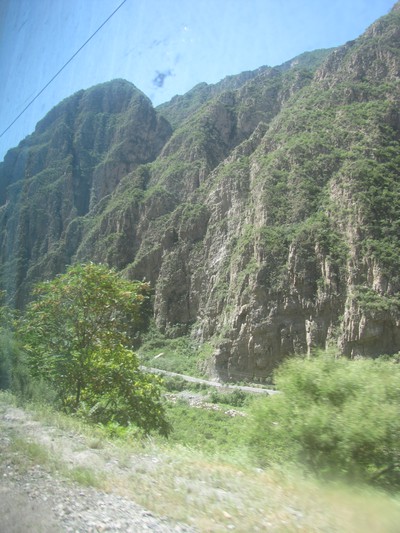
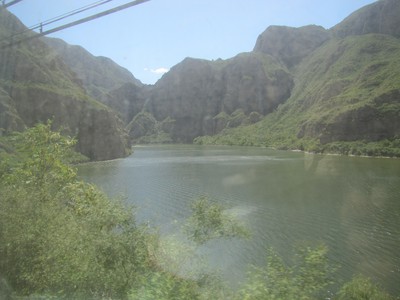

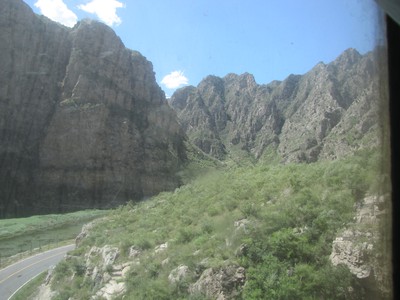



The track went parallel to the Great Wall. but at some distance, for several kilometers around Yanggao. Sometimes one could easily see it.
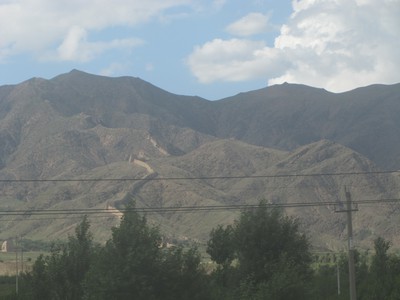
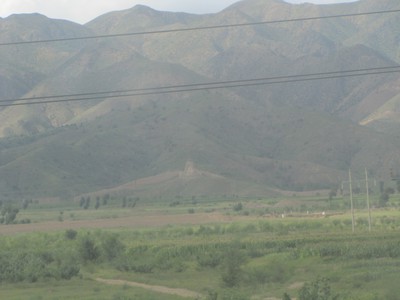
I made friends on the train. My closest neighbor in the bunks was this woman from Baotou, who also took the photo of me that follows.
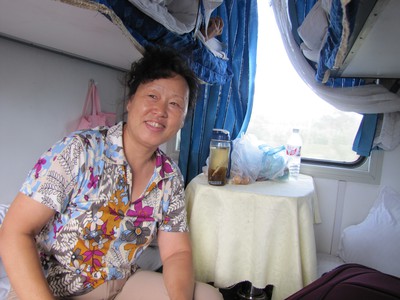
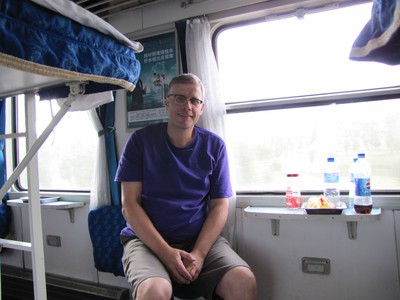
I "spoke" with several others, too, a young couple who were on the second tier in my compartment, a man from Inner Mongolia with wonderful Mongolian facial features (but he did not want to be photographed), and two school girls, who were the only ones who spoke some English. One of the girls was reading The Da Vinci Code in Chinese! She told me that she likes the book.
I am certain that I was the only European on the train, and people were obviously curious. I broke the ice by asking in Chinese the young man where the toilet is. When I came back, a man asked me from where I came. As I answered, there were happy Chinese faces poking out from all tiers of the bunks, following the conversation (such as it was; we had severe problems understanding each other). When I left, everyone said goodbye, zaijian!
OK, so I mentioned the toilet. I am sure you are all curious about what it was like. It was cleaner than some toilets I have seen on SJ trains (Swedish rail company).

But the style was standard squatting, Asian-style.

I started out from Beijing Xi. The always wonderful Ningping accompanied me there in a taxi and guided me so that I would get to the right place.

I thought the station in Basel was big and crowded. This one was enormous in comparison. I took the photo at a moment when it was not so crowded.

The picture above is from the main concourse. On the sides of it were (12, I think) different waiting rooms. A big sign directed travellers to a specific waiting room depending on which train one wanted. Then there was a special waiting room for "mothers with children" (!) and disabled people. Since I am greatly disabled in my knowledge of Chinese, I was allowed to wait there (people in that room get to board the train first).

When we first arrived, my train's number was displayed in red, which means that it was delayed. It did not say for how long, and a special sign said (in Chinese; Ningping interpreted) that they were trying to find out how late is was going to be. When I realized that the train had started out from Nancheng in Southern China at 11 a.m. the day before (and was supposed to leave from Beijing at 9.36, I despaired and expected it to be many hours late. Just as I was considering whether I would be able to change my ticket for a later train that might leave earlier did a time pop up for my train.
As you all can see, the sign tells us that the 1483 to Baotou (which is in Inner Mongolia) would leave at 10.12.

The train arrived, and I got onboard to the space that was mine, with kind help from the railway personell. The train (no. 1482/1483) runs Nanchang-Baotou, which is a distance of 2398 kilometers, and which according to the time table takes 35 hours and 4 minutes. I was only on it for a little more than 6 hours.


The train was enormous and absolutely packed. I never saw the end of it. I was in car 12, I walked to car 15-16 before turning around, not even then being sure where the end was. It must have had more than twenty cars. It started and ran very smoothely (Chinese railroads maintains their tracks, even out in the boondogs, considerably better than do American railway companies). Only when the train broke was there ever a jilt. I guess the train does not have the most modern braking pads. The fact that the train number does not have letter in front of it, means that it is an old, "traditional" train that stops often.

Most of the train are cars with couchettes (Sw. "liggvagn"), and I had one of those. The berths were comfortable, and - miraculously - not shorten than I. I even took a nap. But most of the time, I was at the window taking in the view and snapping photos.


So some view from the windows, dirtier than the Swiss windows, but I have a better camera now, so the pictures came through. Soon after leaving Beijing Xi did we meet a freight train, which was turning off to another route. It was very long, probably some 40 cars, and I think it was headed by two engines (much like the trains of iron ore from Blötberget to Domnarvet in my childhood, for which we often waited forever at the crossing on the way from Ludvika to our home outside town). China transports very much of its internal freight by train. A very good idea.

A clear sign of industrializing China: high-voltage tranfer lines, heavy work in a dry riverbed, and a provisional (?) bridge over it.

Our track was joined by a track coming from the side on a slender bridge. A single track only, but I guess that they are building a second bridgs on those pillars in the foreground.

We approached the mountain range that I think is called the Western Hills. Soon we were going up the mountains, which produced many astonishing sights. Some of the best were visible so briefly that I had no chance of photographing them. There were very many tunnels (can I guess 30-40), some of them very long, several kilometers.
The route we took is a short cut built, I think, in the 1950s to supplement the original route which I believe I shall take back to Beijing.

The train windows now produced wonder upon wonder.









The track went parallel to the Great Wall. but at some distance, for several kilometers around Yanggao. Sometimes one could easily see it.


I made friends on the train. My closest neighbor in the bunks was this woman from Baotou, who also took the photo of me that follows.


I "spoke" with several others, too, a young couple who were on the second tier in my compartment, a man from Inner Mongolia with wonderful Mongolian facial features (but he did not want to be photographed), and two school girls, who were the only ones who spoke some English. One of the girls was reading The Da Vinci Code in Chinese! She told me that she likes the book.
I am certain that I was the only European on the train, and people were obviously curious. I broke the ice by asking in Chinese the young man where the toilet is. When I came back, a man asked me from where I came. As I answered, there were happy Chinese faces poking out from all tiers of the bunks, following the conversation (such as it was; we had severe problems understanding each other). When I left, everyone said goodbye, zaijian!
OK, so I mentioned the toilet. I am sure you are all curious about what it was like. It was cleaner than some toilets I have seen on SJ trains (Swedish rail company).

But the style was standard squatting, Asian-style.

Kommentarer
Trackback
